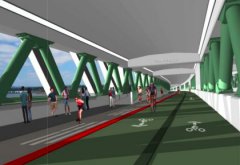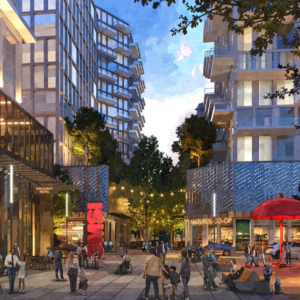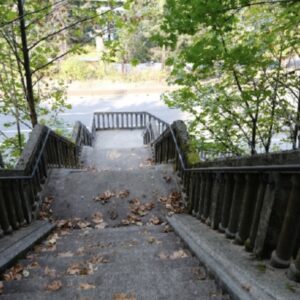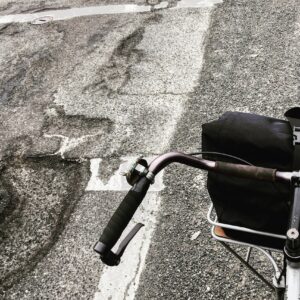
commitment that it will stay
that way.
As we reported last month, the new I-5 bridge design that has won most favor with Columbia River Crossing (CRC) project staffers and advisers is a “stacked” bridge with the bike and pedestrian path underneath.
Below-deck bikeways have typically been shunned by bike advocates because of security and maintenance concerns. The Multnomah County Bike and Ped Advisory Committee, for instance, rejected a similar design option for the Sellwood Bridge. In a recent story, advocate Michelle Poyourow with the Bicycle Transportation Alliance (BTA) said, “Something underneath we’re concerned about, not just because an absence of safety but a feeling of safety… I fear it will go underused.”

However, a two-bridge design with the bike/ped path underneath still came out on top after a 42 criterion design analysis (by the CRC Pedestrian and Bicycle Advisory Committee) of the three bridge options (the other options were three bridges and two bridges with the bike/ped path on top).
“The maintenance and the placement of the path under cover are inseparable in our minds.”
— Michelle Poyourow, BTA
The committee also issued a draft outline of their recommendations for how CRC planners should deal with security and maintenance measures on such a design. They call for security cameras, regular police patrols, bright LED lighting, call boxes, and so on (see full list below).
Poyourow says that their support of the below deck path design is wholly dependent on a commitment to these maintenance guidelines. She says they want a commitment not just from the CRC’s Project Sponsors Council (PSC), but from an agency or government that will exist well into the future.
In an email about the maintenance guidelines, Poyourow wrote:
“Without a commitment… to maintain and operate an under-bridge path to the standards laid out by the CRC PBAC, we do not support the under bridge path… The maintenance and the placement of the path under cover are inseparable in our minds.”
Here is the full text of the PBAC’s Recommendation for a Maintenance and Security Program
The best and most effective method of enhancing maintenance and security is to design a functional facility that is inviting to and well used by the general public. Design principals that provide natural surveillance, territorial reinforcement, and natural access control will minimize on-going maintenance and security requirements. A reliable and funded program will be required. The program must recognize that a poorly maintained facility could undermine the value of good design.
The maintenance and security program shall include, but not be limited to, the following:
- Identification of reliable funding sources and responsible parties for maintenance and security
- Commitment of reliable funding sources and responsible parties for maintenance and security
- Demand responsive and prompt facility management and maintenance
- Opportunities to “program the space” and support activity (e.g., kiosks, overlooks, vendor opportunities) to provide “eyes on the pathway”
- Ensure 24 hours a day, seven days a week pedestrian and bicycle access to and across the bridge and its connecting pathways
- Visible and regular on-site monitoring by law enforcement officers or security staff
- Security cameras monitored by law enforcement officers or security staff
- Call boxes to enable bridge users to report immediate maintenance needs and security concerns
- Efficient, sufficient, vandal-proof, no glare and dark skies compliant clear, crisp, white LED lighting
- Clearly posted laws and ordinances
- Advance notification and posting of maintenance closures and detours
- Citizen and volunteer participation shall be encouraged for future maintenance, operations and programming
The PBAC recommends that the above outline of elements form the basis for a detailed maintenance and security program that is regularly reviewed, performance-based and contains measurable metrics.
In other CRC news, economist Joe Cortright penned an editorial in Saturday’s Oregonian where he called it, “a bridge we don’t need and can’t afford.” Then, The Oregonian Editorial Board answered with a piece in the Sunday paper which stated, “Replacing the bridge is imperative not just for our region, but for improving traffic flow along a vital national freight corridor.”







Thanks for reading.
BikePortland has served this community with independent community journalism since 2005. We rely on subscriptions from readers like you to survive. Your financial support is vital in keeping this valuable resource alive and well.
Please subscribe today to strengthen and expand our work.
“Security cameras, regular police patrols, bright LED lighting, call boxes” .. sounds like a prison.
sounds like a prison
Or maybe a secure safe transportation route across a large river that will keep riders dry in inclement weather. It would certainly beat the existing ride across the I-5 on a bike.
out of sight, out of mind.
That configuration is creepy — I would think twice before rolling through there during the day (kind of like some of the overpasses on the 205 bike path), and forget about riding it at night.
Presumably there will be no corners, nooks, or crannies for people to hide around/in, that will help to some extent. It seems obvious to me that people will be perma-camping there before long though.
Can someone from BTA please clarify — this pertains to BTA’s support for the bikeway design, not the CRC project itself, right? Because regardless of the bike facilities, I don’t think bike advocates should be supporting the CRC in its current form. As Cortright’s article and much other discussion over the past year or so demonstrate, much of the money poured into this 1960s-style, unnecessary disaster ultimately will come out of the pot of money available to build and repair transportation infrastructure — including, perhaps, bike facilities? — in Portland, rather than further subsidizing suburban sprawl in Washington.
Even if they made the bike paths out of platinum, and stationed fan boys and girls along side to hold umbrellas over our heads and hand out free microbrews to CRC bicyclists, I wouldn’t want BTA supporting the massive waste and welfare sprawl of this CRC vision. I don’t know how influential BTA’s support would be anyway, but I hope we can’t be bought off so cheaply. No matter how good the bike facilities are, the current CRC is ultimately bad for bicyclists and anyone else who favors livable communities and sustainable transportation and development.
brettoo… Poyourow told me that the BTA’s position on the maintenance guidelines “does not guarantee our support for the overall project.”
so, to be clear, they are working on the design issues completely separate from their stance on the bridge overall… which, last time I checked was that they were against a 12 lane solution and were working to make sure it is smaller.
So 12 lanes will be acceptable if we have commitment that the “tunnel” will be maintained?
And if they do not commit? What will the BTA do then?
Thanks for clarifying that, Jonathan. Anyone know — how many bicyclists do they estimate will use the new bridge per day?
I’m concerned that getting interested parties to sign off on hypothetical design elements – 12 lanes, stacked pathways, etc. – is, in part at least, a strategy of creating an aura of ineveitability around the CRC.
Joe Cortright’s recent op-ed helps take the shine off that aura:
http://www.oregonlive.com/opinion/index.ssf/2009/07/columbia_river_crossing_a_brid.html
…and helps make this thing seem a whole lot more evitable.
Ever stand under the 405 in West Portland? It is loud as all heck, not as bad as the Glenn Jackson Bridge perhaps but really quite loud. Will this design do something to try to insulate riders from the sound of traffic above?
#8 brettoo,
I’m curious about that too… Though I could see it being hard to predict. Good bike facilities might produce a welcome sort of induced demand, getting more people to bike the crossing. But enough to make it worth it? Just the vertical gain alone on a bridge this big could prove discouraging to many bike riders.
In general, I wonder if this potentially fantastic bike path serves as a kind of monkey trap: appealing, but not worth holding onto. At what point might the BTA decide that the CRC bike path is just that kind of deal? Pretty nice in and of itself, but not worth the potentially detrimental effects of the sprawl-enabling, car-spewing monster bridge that comes with it.
I do not want this bridge built.
But IF it does, I must have missed the part about getting the bike/ped paths on the top deck. Would that not be less noisy and less sketchy? A translucent glass canopy to protect from weather and some park space would be ideal, and the slightly steeper approach would be well worth it if you were rewarded with a pleasant space.
I sailed under the bridge this weekend and had a thought…IF it gets built and the current bridge is demolished, we should demand to have one of the dozen or so green trestles re-purposed over the 405 @ Flanders like what was about to happen with the old Sauvie Island span. After all, what is an extra $5M when they want to spend $4B??
skodt #12,
I think I saw somewhere that having motor vehicles on the top deck is much less costly from an engineering standpoint (not that the current cost and the money already spent is some great bargain).
That said, yes I agree it would be a whole lot better to have peds and cyclists on the top deck. We’d get wet, but this is Portland so it wouldn’t be the first time.
I’m all for having a park on top. How cool would it be to have summer concerts up there with bike and MAX access? Maybe it would be too windy, but an idea. At least a cool place to picnic.
I would rather go over to the 205 bridge than under a freeway. In a dark tunnel like space. The noise would be nuts.
peace
kev
Underneath just seems like problems, homeless, trash, like Toddistic said, out of sight, out of mind. I would rather be visible to traffic, where, if there was a problem, some good samaratin would at least call for help. Underneath, off hours alone, no one sees what happens. And the cost of maintaining security, cameras, ?? How would a woman feel crossing alone underneath, as opposed to on the same level as traffic?
Anybody entering into a discussion of bridge design is just selecting the rope that will make their noose. It’s a distraction and a waste of time. Kill this bridge. Kill it now, before another monthly $1000000 goes out the window.
the lower deck will just end up smelling like urine. bad idea.
Jonathan:
I understand that it’s your responsibility to report this news, but I do not know why the BTA is giving any thought to the bike facility design. Say what they want, every time they do this, they are legitimizing this project.
How visible are you on the current bridge?
Other than in stand still traffic, as a cyclist you aren’t on the radar of drivers. They don’t see you, they don’t look for you. They have enough on their plates trying to avoid the other drivers.
How much patrolling is done on the current bridge?
None.
You could be picked up and thrown off the I-5 bridge and not a single driver would see it. The only people to witness the event would be the boaters below. And they’d be b!tching about cyclists interfering with their fishing.
The safety and security concerns related to this solution are a crock. Take a look at the current bridge, would you consider that safer and more secure than this solution?
This argument about safety is grasping at straws.
.
The sketch in this article (and many other design sketches) seem to imply that a significant number of people might actually walk across the bridge. The bridge itself is not a super long span, but there are practically zero destinations on the Oregon side within a mile of the river.
All my support to the person who commutes on foot from Vancouver to anywhere in Portland (or vice versa) but I don’t think that person exists.
The bridge (if built) should provide a safe walkway, but certainly does not need to offer the 6-walkers-abreast implied in the sketch.
I would be wary of any solution that requires maintenance – because maintenance is the first thing to be cut when the budget goes sour.
I would likewise be wary of any agreement mandating maintenance. Does anyone know of an instance where that has worked? Is it enforceable in court?
The ideal design would be one which requires no regular maintenance. Second would be one where maintenance requirements are low enough for self-policing by users to keep the route in operation.
Looks nice my ass! I don’t want to ride a bike anywhere near a f-ing 12-lane freeway, or live near one, or ever see one again.
The BTA is giving tacit support for this freeway expansion project by even considering support for its offensive bike-path.
Ms. Poyourow, here’s 15 cents: Go buy yourself a clue!
What about walking to Jantzen Beach to shop? This would be more likely to happen with a nicer walkway.
There’s also the Expo center and fair grounds pretty much within walking distance.
Throw the toll you want on the bridge and you’ll see more people choosing to walk to some of these locations rather than paying to drive.
Nobody should negotiate so that less of what you value is stolen away. The BTA should pull out of the facade advisory committee.
I let the BTA know my concerns by calling and speaking with their staff. Call them at (503) 226-0676.
Both the BTA4bikes.org and the CLFuture.org are toothless in their CRC opposition. They CAN NOT ask members to call and put pressure on lawmakers or they would violate their non profit status.
The public should trust them, but not trust that they are able to oppose this bridge of any lane configuration.
http://preview.tinyurl.com/401c3lobby
I oppose any new bridge.
However, the further I am from cars, the happier I am. Some of my favorite routes, such as the Eastbank Esplanade and Springwater, don’t have cars near them, and based on the use of those routes, I don’t think it’s discouraging anyone from using them.
That said, I think such a configuration should emphasize a people-forward approach, with plants, benches, and so forth which would encourage folks just to visit the bridge to sit and relax. This might be difficult with a freeway overhead!
Is it completely ridiculous to propose simply a new pedestrian/max train bridge and keep the existing bridges as-is? That new bridge could be stunning, a park above the water that helps active travelers go between two wonderful states.
Does anyone know how they ‘maintain’ our ped/bike paths currently? Do they have small sweepers/washers that come through?
By coincidence, I just received notice from the BTA announcing first BTA Advocacy Forum on August 15. No details on where or what time yet, but I’m sure the BP team will keep us posted. Maybe will be a good forum to discuss this and other issues with BTA staff.
They will promise the Garden of Eden with bikepaths.
Then they will trim the fat and provide leaner and more cost effective maintenance and security.
Then they will divert funding or flat out cut the budget.
Finally, why spend any money at all on a facility no one is using, except the transients, drug dealers and addicts.
If it requires a promise and a commitment from a politician to work, do not do it.
In general, I’ve thought the CRC bridge proposal is a dubious one at best; ultra expensive, likely to enable sprawl which area leaders seem loathe to address. Still, powers that be seem intent on building the monstrosity.
Upon first hearing about it a while back, the idea of pedestrian and bike ways on the lower level didn’t seem that bad an idea to me. This design would protect those bridge users like once common covered bridges did, right?
After reading, in people’s comments, of the disadvantages to pedestrians and bikers that this design would pose, I agree that the pedestrian and bike way should be on the top most level of the bridge. I hadn’t really noticed much attention paid to the possibility that this level could also be landscaped like a park, but since the feds are willing to fork up so much of the public’s money for this bridge, that seems like an excellent idea. The Highline park in NYC provides an example of an elevated linear park that seems to be a great asset to the city.
There’s a lot of fed money pushing it, so this monstrosity bridge will probably be built regardless of people that have concerns about resulting sprawl and the exhorbitant cost of the thing. I’d rather not see a new bridge built.
I agree with those that feel the pedestrian/bike way on the lower level is a bad idea; the noise, dirt, reduced natural light, security and safety issues make it an unacceptable design option. Though some might suggest it as such, a lower level pedestrian bike way on this huge concrete bridge isn’t going to have any of the charm of an old timber construction covered bridge.
The idea that the top level, in addition to providing pedestrian and bike ways, could be landscaped as a linear park is excellent. NYC’s Highline Park gives an example of the potential this idea has to offer.
Joe Rowe (#25) – That’s not exactly true. They *can* ask members to call without violating their status. The restrictions on 501(c)(3) organizations are 1. They cannot endorse a particular person for office, and 2. They cannot spend more than xx% of their budget on influencing legislation. (I can’t recall the percentage amount and I don’t have the Oregon Nonprofit Handbook in front of me at the moment)
Which doesn’t change your point at all – if they *can* do something and choose not to, that’s even worse from your stated perspective.
If the BTA is saying that they’ll jeapordize their status, then it’s possible that the cost in staff time would push them over that percentage limit – and that would jeapordize their tax-exempt status.
In some respects, the BTA is a victim of its own success, because it’s large enough to warrant attention from the IRS. A small grass-roots organization likely wouldn’t have the money to warrant federal scrutiny.
Hi all…as one of the CRC BPAC representatives (formerly for the City of Vancouver) … now just a citizen.
… the issue of bridge path height is something not to forget.
Moving the pathway from an ‘underside’ to ‘on top’ of the roadway will add 38′ plus of elevation to the future route (my memory). The PBAC is attempting to make the future bridge path a more direct route (straight and lowest) as possible…so more riders use it, etc.
Adding height to the bridge effects 3 things:
– takes more pedaling walking energy to reach the top (the grade of the existing bridge hump is already a barrier for some users)
– lengthens the distance of the landing deeper into downtown in order to meet 5% max slope for ADA ; perhaps as far north to 7th Street (vs. 5th St) and away from waterfront.
– may make it more difficult to get around the highway ramps (thus creating more out of direction travel for bikes).
I have used the top pathway of the Brooklyn Bridge…and other than the great view there was a lot of traffic noise up there. More than we are expecting for the ‘under’ option.
One thing to note in thinking about how much noise to expect under the future bridge…there will be no expansion joint noise and concrete is much quieter than steel. They say 70 to 75 dB vs. up to 85 dB (i205 bridge) – my memory of our PBAC meeting this spring.
Freight? FREIGHT?
Freight, except for a tiny minority of local freight, belongs on the RAILROAD CROSSING. Which the CRC people are simply refusing to consider improving. Probably because it would improve freight and passenger movement so much, and might eliminate the phony “need” for more highway lanes.